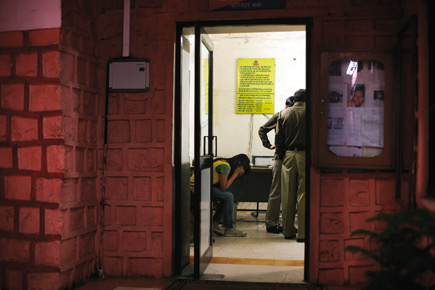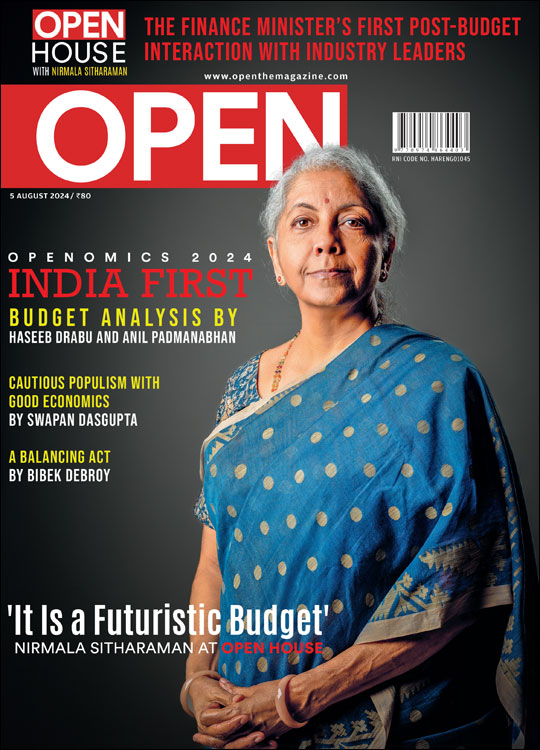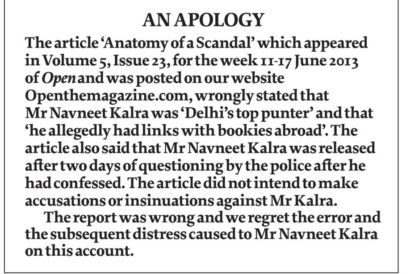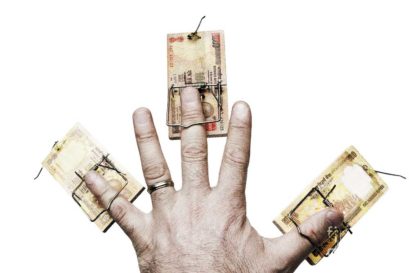No City for Young Women
Delhi as India’s ‘rape capital’ is a sensational label that rings true for reasons both heinous and heartless. One woman’s effort to understand why so little is ever done about it
 Rajni George
Rajni George
 Rajni George
Rajni George
 |
14 Apr, 2011
|
14 Apr, 2011

Delhi as India’s ‘rape capital’ is a sensational label that rings true for reasons both heinous and heartless. One woman’s effort to understand why so little is ever done about it
My cousin, challenged one day to defend his girl cousins from the advances of a tourist, asked the offender indignantly, “Are you half animal?”
“No,” the man replied, coolly, “I’m full animal.”
While this happened elsewhere, it could well have been Delhi, where the issue of women’s safety is ever salient. What is the nature of this beast, and how is the city trying to protect its women?
As women gain increasing prominence in the public sphere, so do statistics of rape and sexual harassment in the capital. Heading the list of India’s women-unfriendly cities, Delhi accounts for 15.4 per cent of the 23,983 cases of urban crime against women in 2009 on the registers of 35 big cities, according to National Crime Records Bureau data (2010 figures are yet to be released); the capital logs 23.8 per cent of rape cases, 38.9 per cent of kidnapping and abduction cases, 15.2 per cent of dowry deaths, and 14.1 per cent of molestation cases.
‘Big’ cases of gangrape and molestation have increased this last decade, yielding the justifiably sensational classic headline: ‘Delhi: capital city or rape city!’ Particularly shocking have been the cases of a young girl raped by two salesmen in Palika Bazaar one 2007 morning, a call centre worker raped by five men last November (one of Delhi’s many ‘Dhaula Kuan’ rapes), and another BPO worker molested returning from office this February, despite a December police order mandating safe BPO escorts home. These incidents underline the chilling 2010 UN statistic of a rape in Delhi every 29 minutes.
It’s a full-blown crisis. This is the consensus of the media, legislators, law enforcement officials and a beleaguered public. Here is a city that does not fully admit its women, who cannot freely ride its buses or walk its streets as they can in Mumbai, for example. It’s plain that Delhi’s women live under siege. This explains the recently acquired edge of militancy in the voice of previously plaintive reporters every time there’s another case.
Less audible is a contingent of negotiators and conflict resolvers who are trying to address this crisis. Joint Commissioner of Police (Crime) Sandeep Goel announced early this year that women’s help desks (new at 185 police stations), a separate police van for Delhi’s 1091 helpline and anti-obscenity and anti-stalking cells (which began in 2009-10 with 10,000 and 40 complaints, respectively, say the police) are all part of a drive to get women under threat to approach the police—traditionally seen as a last resort—as quickly as possible.
The two month-old women’s help desk I visited in January in the surprisingly welcoming Dhaula Kuan police station, is part of this campaign. Located plumb off the highway near Delhi Cantonment, the almost merry-looking red brick thana has the whimsical air of a rural railway station office. Its help desk, with four silent women cops, one in civilian clothes, looks impressively well-prepared. When I look at their register, however, it records few instances of crimes targeting women in an area frequently in the news for just this.
I take the strapping, six-foot son of a diplomat along when I call on the station unannounced one Saturday morning. A woman doesn’t go to a police station alone, as old wisdom has it. And if go one must, it’s best done in the accompaniment of a man with ‘connections’; or so at least in this city that so decadently courts ‘influence’. Once it is established that we are ‘presswalas’, we are introduced to Station House Officer (SHO) Dinesh Kumar with appropriate ceremony. An average-sized guy with a medium complexion, glasses and six stars on his shoulder (indicating at least 10 years’ experience), he has the proud air of a man of some achievement.
Kumar took over as SHO last March. “Log ko crime karna hai, toh karenge (if people want to commit crimes, they will),” he declares. “They are mentally prepared. They think, ‘Delhi ki ladkiyaan available hain’ (Delhi girls are available). They go to hotels and drink. So, day and night, round the clock, preventive action is what we do.” Sitting back in his chair, he lists martial arts classes as necessary for girls, and speaks of women’s cells which offer special commando training to address women’s safety concerns. He breaks down the process by which a complaint is made: “FIR, then to officer, then DC, then chargesheet, then court.”
As he speaks, Kumar casts himself as a man of action: “People call me till early in the morning, and I always answer,” he says of his always-buzzing three phone numbers, even as he casts himself as an all-Indian philosopher. “Indians are soft by nature, chui mui (overly sensitive).”
Offering to demonstrate how open the station is to women seeking assistance, Kumar makes a short call. In 10 minutes, Mona of Satyaniketan appears, an industrious-looking MBA student in her 20s. Kumar had helped Mona’s friend who reported some perverts of a nearby basti videotaping her in her bathroom, and has subsequently aided her in smaller matters such as the loss of her ID card. “I would definitely come here if I had any problem,” Mona says, dutifully affirming her faith in the police.
It gladdens Kumar. “The police are not portrayed positively,” he complains. “Why always Paresh Rawal? Why someone like Shakti Kapoor, why not Amitabh?” He laughs, amused by his own cinematic analogy. Confident of the real picture, or perhaps disarmed by my south Indian-accented Hindi, the SHO agrees to let us accompany him on the night patrol that was instituted 10 months ago to step up security.
Ten odd policemen await the SHO with me and my photographer around 11 pm one Thursday, when a young girl enters; weaving her way into the thana, she is handled by a woman police officer flanked by two male colleagues. The girl, petite and in slightly saggy jeans, says she is under 18. A 100 call reported the noise she and her friends were making on the street nearby, the police tell us. She denies the allegation in fluent English, and claims she told her friends to leave, as they can’t deal with the cops the way she can, “being from an Army background”.
The young girl is clearly unstable—she shows me welts on her right wrist and says she cut them a week ago—and unafraid. She pulls an elderly policeman out of the thana by his shirt, asking him to get her cigarettes, to everyone’s amusement. She shouts “I hate Delhi Police” a few times, seemingly for effect, or by way of drunken repetition, adding though that the lady cop is “very nice”. Almost charming in her turn as playful truant, she is also somewhat streetsmart. “Why haven’t they done a test on me?” she asks, referring to a breathalyser, which we don’t ever see used or suggested by the police. “What have I done wrong?”
If the girl is 18—she somehow doesn’t look it—her drinking is an offence in itself, potentially resulting in a fine and perhaps a few months’ jail time, as the person manning the 1091 helpline I test-call later confirms. Underage drinking doesn’t seem to be the issue here, however. If the police let a young girl run around alone at night on the streets of Dhaula Kuan, she could end up in their registers as another grisly statistic.
The girl refuses to be seen home; her father, she says, has BP and she doesn’t want to upset him by returning home with the Delhi Police. Cockily, she tells me, “I’m not drunk, I can put on my makeup,” lining her lids with kajal successfully, and then comically daubing her eyelids instead of her lips with gloss. Unsaid between all of us is the question of why she is out at night: her disputatious attitude, slightly sloppy attire, her being out alone drunk and with men, all add up to sketchy behaviour for a middle-class kid from an Army family. Of course, in New York she would just be a drunk girl—a drunk person. “I know I’m a bad girl, I drink,” she says to me. I tell her I drink too. She doesn’t seem to hear me.
When the SHO arrives after some 20 minutes, his face is consciously stern as he faces the fiery young girl. She exclaims, “Policemen gaddhe hote hain (are donkeys)!”, claiming her Army officer father serves his country better than the police do. This triggers an instant, almost Pavlovian response from Kumar: “Army people are donkeys!” he counters, almost growling, seeming to have lost some of the control he exercises over himself. It’s not clear if he’s Amitabh Bachchan or Shakti Kapoor at the moment. For when the impudent 18-year-old pokes at his chest in a cheeky part of the show she is obviously enjoying putting on, he snarls, “Don’t touch.” It’s clear the man doesn’t know how to talk to a drunken girl; like many a police officer, perhaps he rarely has.
“The women’s compartment—what does it represent? Is it a solution?” asks gender activist Kalpana Viswanath of Jagori, a non-government women’s resource centre founded in 1984. “No. But till we can provide safe travel for women, we need it.” Men are not ready to share public spaces with us yet in India, I concur, as we chat over the phone one afternoon. Viswanath gently reminds me that even Japan has introduced women’s compartments. As one of a tribe of the longanimously unyielding, Viswanath, with her 20 years of experience, frequently has to make one distinction: this is not just a women’s issue, rather an issue of the city. Jagori is in the sixth year of its Safe Delhi Campaign, working with the Government and police to implement real action in combatting crime against women. Located in a spare set of offices in Malviya Nagar, the NGO is making a dignified effort with a team of around 20, mostly the kind of efficient Delhi School of Social Work graduates who intimidate my less obviously socially conscientious friends, and who quietly get work done.
Viswanath explains how Jagori works at the community level to bring about change. “Change happens when you get used to it. In the basti, for example, we’re teaching men how loitering and staring can affect young girls. Also, we have to break myths—by showing that women who get harassed wear all kinds of clothes.” Other Jagori initiatives include sustained intervention in Delhi University, women’s development centres, equal opportunity cells, work with the Metro and Delhi Transport Corporation (DTC), and facilities for disabled students and women. In terms of immediate practical concerns that Jagori helps address, the strengthening of helpline 1091 is a priority; NGO helplines cannot act on their own. “We need to have one helpline that functions as an effective call centre—get one of the call centres to come in and make things work. But NGOs and civil society should just support the police, as only they can do certain things. Frankly, the system needs an overhaul, years of training and process changes. Better policing, better urban design in terms of public spaces: a range of interventions and changes.”
Several women I speak with are so agitated by sexual violence that they feel life imprisonment or even castration of rapists is the only effective cure. The time for candlelight vigils is over, say Delhi’s angry young women. But every bit counts, adds Viswanath: the new police chief’s displaying extra political will to take this up, the DU DCP telling us of a nearly all-women police station, Nirupama Rao making a public statement about sexual misconduct not being acceptable. “Even five years ago, we didn’t get this much response. Things have conspired so that there is a positive response, and we should make use of this,” she says. Indeed, there are some results; the perpetrator of the 2005 Dhaula Kuan rape case was given 14 years in the slammer and slapped with a Rs 20,000 fine; the accused in last year’s Dhaula Kuan case was reportedly caught after an intense campaign of around 500 policemen.
“People ask me, ‘What are your messages for women?’ I tell them, ‘My messages are to men,’” says Viswanath, “A large number of police in Delhi are from very patriarchal parts of the country. And long-term change ultimately has to come from within the institution of the family and school. What is it we are teaching our boys?” Following pressure a couple of years ago, she adds, Delhi’s government schools have segregated classes by gender so that girls attend in the morning and boys in the evening, thus compounding the problem of gender insensitivity. “Self-defence, pepper spray are all small measures. At the end of the day, if cornered by three men, your self-defence class won’t help you, let’s be realistic. It’s important, and I would encourage it. But it merely throws the problem back on women. At the end of the day, you have to put the lion in the cage.”
The National Commission for Women (NCW), India’s ‘apex’ women’s affairs organisation, was founded in 1992. It is housed in an oldish government-style edifice on Deen Dayal Upadhyaya Marg, and bears that slightly marginalised air of a women’s organisation. Its president, Lok Sabha member Girija Vyas, exemplifies politician chic in her silk sari and requisite gold. She speaks as she is massaged by an inscrutable old lady whose eyes shut for long intervals. “The challenges are many, but the paradoxes are also many,” says Vyas, author of eight books. “We are climbing to the moon, women are speakers, IAS officers, etcetera, but in the last few years, crime has gone from 8 to 21 per cent.” She explains that 27 laws have been taken up by the NCW, helping effect constitutional and legal safeguards for women; two or three have been passed and more are on their way. Then she begins reeling off points off a numbered list: “One, rape, molestation, abduction, dowry deaths are on the rise; two, the definition of rape should be legal; three, execution should be strong; four, the role of civil society; five, the role of media…” Initially I wonder if she is citing some report. Soon, I realise that this is her language.
Like another woman MP I met earlier, Vyas reminds me that she has another role, that of a politician—“My term will soon be up”—and then resumes her daily iterations to the regional press people who have arrived for a small conference around a recent Dalit rape case in Uttar Pradesh. Dismissing me, she says, “You can (she makes a fluttering motion with her fingers, emulating typing) read the rest on the web.”
Before the Vyas meeting, I was vetted by her weary PRO, Kareena B Thengamam. A sweet, slightly dreamy type, Thengamam is named after Anna Karenina, thanks to her journalist father’s time in Russia, and has been with the NCW for two years. “We control what we tell the media,” she says carefully, preferring that I speak with ‘Ma’am’. A mound of files on her shelves and a nest of paper on her desk attest to the sustainable chaos of her operation. “These papers shows how busy and important madame is,” a Punjabi paper journalist tells me in that familiar ritual of flattery common to government offices, but somehow out of place in this musty, crowded room literally filled with women’s affairs. It’s Punjabis and their flashy brand of mercantilism that are responsible for the rise of aggression, he continues.
“The main thing is that people are not being convicted,” Thengamam offers after a while, partly, if gently, ignoring the man. “Unless a girl dies, men don’t feel there will be consequences.” The Supreme Court recently let off three gang rapists with a fine of Rs 50, 000 each and 3.5 years already served, despite legal stipulations that the minimum sentence for gang rapists be 10 years; Delhi is letting rape verdicts be negotiated, in the manner of petty crimes. Clearly, the fear of consequences is not strong enough.
The Parliament annexe I visit on another day is closer to the powers that be, and while similarly old school, its corridors are not quite as lugubrious. Within it, MP Oscar Fernandes heads the Parliamentary Standing Committee on Human Resource Development addressing concerns of domestic workers under the aegis of the Protection of Women against Sexual Harassment at Workplace Bill. I settle down for the government office wait in a set of rooms where he is meeting bouquet-bearing petitioners and supplicants—50 daily visitors on average, the receptionist tells me. Salwar and dupatta notwithstanding, I am the only woman among 30 bored, mostly khaki-clad men trying not to stare. Fernandes’ right hand man BP Singh, a soft-spoken JNU man with a limp, joins me as we wait, drinking soup from little tea cups that are passed around as we discuss the Bill and women’s safety issues. “We should do something, we should organise a conference,” he says, calmly.
“It’s a fine balance,” well-spoken Fernandes explains when we speak, half an hour later. “Nowadays, people are working day and night. Earlier we used to ban working at night. And the victims—they have suffered and need justice. How do you protect the complainant? How do they go back and work where they have complained?” He weighs his words. “We are examining, not commenting. This issue of harassment is a very personal thing, between two people.” These are, he stresses, issues of governance, not of judgement.
I leave a crowd vying for his attention as people swarm in to seek his signature. On my way out, I joke with the canny peon I have been watching scurry around the corridors of power, asking about the flowers he is putting away. “Ma’am, you only take them,” he tells me spontaneously. “Yahaan toh bahut saare hain (We have enough here).” I demur, but the MP’s staff chorus that I should take them. “Actually,” says one, timidly, “I was going to give them to you earlier, when they came in. But, I thought, it’s not right for a man to give flowers to a woman.”
I debate for a minute, but it has been a while since I was given flowers in today’s politically correct, anti-Valentine’s Day culture; I accept the bouquet. His little speech, in this building where men give each other flowers all day as part of the-rituals-that-get-things-done, is the sweetest and perhaps most tragic thing I’ve heard in a while.












More Columns
Art of Love Nandini Nair
Fruit of the Nation Madhavankutty Pillai
Ladakh: Magic Mountain Abhilasha Ojha